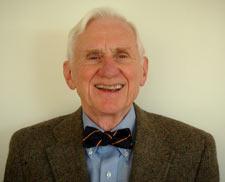
Artisans throughout the ages have smelted, melted, blended, and molded metals, but it was not until the 20th century that scientists and engineers methodically tried to improve the process. In post-World War II America, the field of metallurgy was coming into its own after extensive study during the war. At a time when everyone could foresee that refrigerators and cars would soon populate most U.S. homes, it was an exciting field with plenty of room for innovation. When Merton Flemings first studied metallurgy—he entered MIT as an undergraduate in 1947—one could either expensively stamp out a shape from hard metal, or cheaply create much weaker forms from molten metal. Since then, Flemings has revolutionized metal working. By studying the behavior of the materials on a chemical and structural level, his discoveries have led to making metal simultaneously stronger and lighter for cars, airplanes, sporting equipment, and computers.
After receiving his bachelor's degree, Flemings went on to earn his Sc.D. in 1954 in metallurgy, also from MIT. For two years he worked directly in industry, but by 1956, he had returned to MIT as a professor, where he remains to this day. One of his first triumphs was to create better molds. Flemings took a cue from artists who were using a new special kind of foam to cast statues. He covered this foam with a slick ceramic coating, as opposed to the contemporary standard of wax surrounded by sand and clay, and found they could create exact shapes far more precisely.
In 1974, he literally wrote the book on "Solidification Processing" (that was its title), and industry began to apply his metal molding techniques to their own production lines. One of his best discoveries was yet to catch on, however. An inherent problem working with molten metal is that some sections harden before others into complicated branch patterns called "dendrites," and the remaining molten metal doesn't flow well into the open spaces. The holes in the resulting metal make it weak and deformable. Working with doctoral student David Spencer in his lab, Flemings discovered that continual stirring of a partially solid and partially liquid metal broke up the dendrites, creating a more evenly-distributed final product. This process, known as semi-solid metal forming, truly took off in the 1990s when automobile manufacturers realized this homogenized metal provided metal parts that were lightweight, yet much stronger and less expensive than anything they currently produced.
Today, metal parts are made around the world for millions of applications using semi-solid processing. Flemings continues to work at MIT trying to understand the nature of the materials themselves in order to create even more fluid semi-solid metals for better casting. He has worked closely with industry throughout his career to better understand exactly what needs and problems industrial leaders have. He is the author or co-author of 335 papers and two books, and holds 31 patents.
Starting a new field of metal processing has also earned Merton Flemings numerous awards. To name just a few: the Simpson Gold Medal from the American Foundrymen's Society (1961), the Mathewson Gold Medal of TMS (1969), the Henry Marion Howe Medal of ASM International (1973), the Albert Sauveur Achievement Award from ASM International (1978), the John Chipman Award from AIME (1980), the James Douglas Gold Medal from the AIME (1985), the TMS Leadership Award (1990), the Merton C. Flemings Award from Worcester Polytechnic Institute (1991), and the Bruce Chalmers Award (1993).
Information as of April 2007

